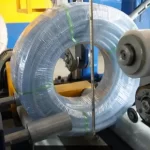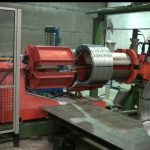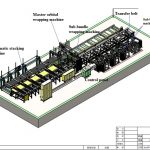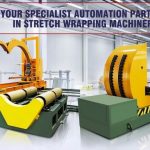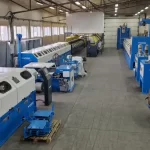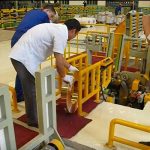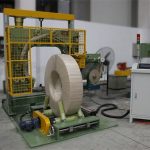Guideline for Coil Packing Line Instrumentation, Control, and Automation
- Guideline for Coil Packing Line Instrumentation, Control, and Automation

1. Introduction to Automation in Coil Packing Lines
Automation in coil packing lines is essential for improving operational efficiency, ensuring consistent packing quality, and enhancing safety. With advanced control systems and precise instrumentation, modern coil packing lines minimize manual intervention and allow for faster production rates. This guideline covers the essential elements required to automate and control coil packing lines, ensuring seamless integration with upstream processes like slitting lines and downstream operations like storage and shipping.
2. Key Components of Control Systems

2-1: PLC (Programmable Logic Controller)
PLC (Programmable Logic Controller) is the central hub or "brain" of the coil packing line, responsible for integrating data from various sensors, controlling mechanical movements, and coordinating each stage of the packing process. Modern coil packing systems often rely on advanced PLCs like the Siemens S1500, known for their reliability and scalability. This PLC system ensures that operations run smoothly by processing real-time data and adjusting machinery accordingly to optimize the packing process. It controls everything from conveyor speeds to wrapping tension and strapping strength, guaranteeing precision and efficiency throughout the line.
In addition to basic control functions, the Siemens S1500 PLC can be expanded with extended modules that enhance its capabilities. These modules allow for the integration of additional sensors, safety systems, and external devices, providing greater flexibility to customize the system according to specific production needs. Furthermore, the PLC’s support for Profibus, an industrial communication bus, allows for high-speed data transfer between the PLC and other components of the system, ensuring synchronized operations across all machinery, including slitting lines, wrapping machines, and strapping stations.
With its built-in calculation functions, the PLC can also manage complex processes like real-time diagnostics, load distribution, and energy consumption analysis. This not only helps to ensure operational stability but also provides valuable insights for predictive maintenance, helping to avoid unplanned downtime. The combined functionality of the PLC makes it an indispensable tool for ensuring seamless, efficient, and scalable operations in modern coil packing lines.
2-2: HMI (Human Machine Interface):
HMIs (Human Machine Interfaces) are touch-screen interfaces that allow operators to monitor and control the coil packing line in real-time. These interfaces provide an intuitive platform where operators can set key parameters such as coil width, weight, and wrapping tension, ensuring that the system is customized to meet specific client requirements. HMIs are crucial for overseeing the entire process, from coil loading to final packaging, enabling operators to make adjustments quickly and efficiently.
With the integration of open-source programs, HMIs can be further customized, allowing for additional features and flexibility based on the specific needs of the operation. Moreover, these interfaces can save operation data, storing key metrics like production rates, coil specifications, and equipment status for later analysis. The operation log feature records every action taken by the operator, ensuring traceability and providing valuable insights for troubleshooting, audits, and continuous improvement. This combination of real-time control, data storage, and logging makes HMIs an indispensable tool for efficient and transparent coil packing operations.
2-3: Servo Drives and Motors:
Servo drives and motors are essential components in controlling the precise movement of equipment in a coil packing line, including wrapping machines, turntables, and down-enders. These systems ensure highly accurate positioning of coils, reducing the margin for error during the packaging process. The servo system typically includes several key components: the servo motor, which provides controlled motion; the servo drive, which regulates power and controls the motor’s operation; and feedback devices like encoders or resolvers, which provide real-time data on the motor’s position, speed, and torque.
This combination allows for incredibly precise motion control, ensuring that equipment performs movements like coil rotation, wrapping, and strapping with exact accuracy. The feedback loop within the system continuously adjusts the motor's actions based on real-time data, leading to smoother operation and fewer errors. With servo systems, coil positioning and wrapping are executed with a level of precision that not only enhances product quality but also improves the overall efficiency and reliability of the packing line. These systems are ideal for applications requiring tight tolerances and consistent performance, such as handling varying coil sizes and weights.
3. Instrumentation for Precision Control

3-1:Sensors and Encoders:
Sensors (such as proximity sensors and photoelectric sensors) and encoders are crucial components in the automation of a coil packing line, providing real-time data that enables precise control over the entire process. These devices detect coil positions, measure dimensions, and monitor movements. The data collected is sent to the PLC (Programmable Logic Controller), which makes real-time adjustments to ensure accuracy throughout the packing process.
In practical applications, encoders are often used for tasks like coil pick-up, where they ensure that the coil’s width is correctly measured and that the system adjusts for precise positioning. Encoders are also applied in coil stacking to monitor the height level of stacked coils, ensuring that each coil is placed accurately and securely. Sensors play a key role in various stages of the packing process, such as detecting when a coil has reached the correct wrapping or strapping position. Together, sensors and encoders ensure seamless operation, reducing errors and improving efficiency in coil handling, stacking, and packaging. These components are essential for maintaining consistency and precision across the entire system.
3-2:Load Cells and Tension Control Systems:
Load cells are highly precise instruments integral to the efficient operation of a coil packing line. They are specifically used to accurately measure the weight of coils, ensuring that each coil is handled according to its specific weight capacity. These devices are designed to measure both the gross weight (total weight including packaging) and the net weight (the coil's weight alone), which is crucial for maintaining balance during stacking and transport operations.
The precision of load cells, with an accuracy of 1/3000, allows for detailed and reliable weight measurements. This precision is essential in preventing overloading, which could otherwise lead to equipment failure or unsafe conditions. By providing real-time data on each coil's weight, load cells enable operators to make informed decisions about handling and processing, ensuring that the packing system operates safely and efficiently, especially when dealing with heavy coils.
3-3:Tension Control Systems:
Tension control systems play a crucial role in the efficient and safe wrapping of coils during the packing process. These systems are designed to regulate the application of stretch film, ensuring that it is applied with the correct tension. This precision is vital to prevent under-tensioning, which could result in inadequately wrapped coils, leaving them vulnerable to damage. Conversely, over-tensioning could harm the coil or compromise the integrity of the wrapping material, leading to potential failures during storage and transport.
The ability to finely adjust tension control is particularly important when dealing with different types of materials such as paper, fabric, or stretch film. Each material has specific requirements regarding how it should be applied to provide optimal protection. Tension control systems allow for these adjustments, ensuring that each type of protective material is applied correctly according to the specific needs of the coil.
4. Automation in Key Processes
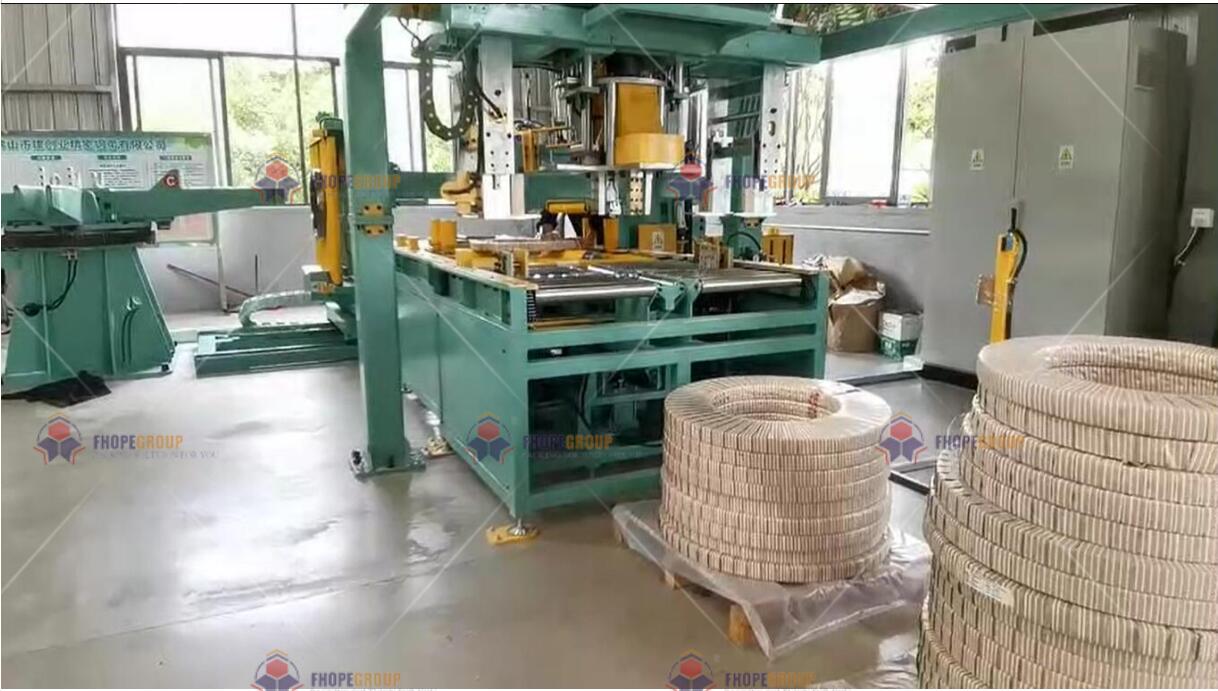
4-1:Coil Transfer and Positioning:
In a coil packing line, automated conveyor systems, down-enders, and turntables are essential for the precise movement and positioning of coils. These systems, often motor gear, hydraulic & servo-driven, work together to ensure that coils are transferred seamlessly from one stage to another, whether for strapping, wrapping, or storage. Down-enders rotate coils from a vertical to horizontal position, while turntables allow for precise rotation to ensure coils are oriented correctly for further processing. The use of V-shaped platforms helps stabilize the coils during transfer, preventing movement or damage.
To support this automation, the system requires a solid foundation. A well-designed foundation is essential to ensure stability, as heavy coils and machinery need a firm base to operate safely and efficiently. The foundation must be engineered to handle not only the weight of the coils—ranging from hundreds to thousands of kilograms—but also the vibrations and movements of the equipment. Proper foundation design helps prevent misalignment and ensures that the automated systems operate at their full potential, maintaining accuracy and efficiency throughout the coil handling and packaging process.
4-2: Automatic Wrapping Machines:
Automatic wrapping machines utilize rotary rings and inverter controls to efficiently apply stretch film uniformly around each coil. These machines are equipped with inverters that adjust the ring speed and the overlap rate of the wrapping tape according to specific requirements. The tension applied by the wrapping machine is adjustable through the control system, ensuring the correct level of protection for different coil sizes. This is achieved by modifying the tension of the packing tape, which can be precisely controlled to accommodate variations in coil dimensions.
For different coil sizes, the packing material length is calculated, and the machine offers automatic cutting options. This flexibility allows for efficient use of materials and ensures that each coil is wrapped with the optimal amount of protective material. The machines support various materials for wrapping, including paper and fabric, providing versatility in packaging options based on the specific needs of the product being wrapped. This adaptability makes automatic wrapping machines an essential tool in industrial settings, capable of handling diverse wrapping requirements with precision and reliability.
4-3: Coil Stacking and Storage:
Automated coil stacking systems are designed to stack coils onto pallets or storage racks with precision and minimal manual intervention. Equipped with sensors and encoders, these systems ensure accurate placement of each coil, preventing misalignment or damage during the stacking process. The use of vacuum lifters or hydraulic lifters further enhances safety by securely lifting and placing coils without the need for manual handling, reducing the risk of coil damage.
The stacking parameters, such as the number of coils and coil width, can be easily set within the control system, allowing for tailored stacking configurations. This feature enables the stacking to be customized per the customer's order, ensuring that each batch of coils is stored or shipped according to specific requirements. Additionally, integrating a turntable stacking section provides greater flexibility in stacking modes and coil selection. With this feature, operators can rotate and position coils for optimal stacking, whether for space optimization or preparing orders with different coil specifications. This flexibility and automation streamline operations, improve safety, and ensure that coils are handled and stored with maximum efficiency.
5. Data Sharing and Integration with Upstream and Downstream Systems

5-1: Integration with MES/ERP Systems
Automation systems in coil packing lines can seamlessly integrate with Manufacturing Execution Systems (MES) or Enterprise Resource Planning (ERP) systems via APIs. This integration allows for the real-time exchange of coil specifications, production data, and operational performance, ensuring smooth communication across different departments and systems. Beyond the hardware components of the coil packing line, the software and programming play a critical role in this integration. It is essential to customize the software to match specific operational requirements, which should be thoroughly discussed before placing an order. Custom programming ensures that the system accurately reflects business workflows, from coil dimensions to production scheduling, and delivers data in a format that integrates seamlessly with existing MES or ERP systems.
5-2: Upstream Integration with Slitting Lines
The coil packing line can integrate with the slitting line’s PLC via Ethernet or Profibus, ensuring real-time sharing of data such as coil dimensions and cutting specifications. This automation helps to reduce setup times and minimizes errors during production. The integration is crucial for key processes like coil picking, wrapping, and stacking, where precise coil specifications are essential for smooth operation. Additionally, if the system includes printing or labeling features, the upstream data integration ensures that labeling information—such as product details and barcodes—is correctly transferred from the slitting line. This not only enhances workflow efficiency but also ensures that the packaging and labeling of coils are accurate, consistent, and aligned with upstream production details.
5-3: Barcode Scanning and Tracking
Barcode scanning and tracking systems are often integrated into the coil packing line to enable accurate product tracking and inventory management. These barcoding systems provide real-time updates on coil status, helping to manage the flow of materials throughout the logistics chain. Barcodes also enable precise inventory management, allowing companies to track each coil’s location, history, and specifications. The scanned information is often connected to MES or ERP systems, ensuring that the production status and storage conditions are always up to date. This level of visibility helps improve supply chain efficiency, reduce errors, and streamline overall operations, from production to distribution.
6. Safety and Error Management
6-1: Safety Instrumentation
A well-designed automation system for coil packing lines must incorporate comprehensive safety measures to protect operators and prevent accidents. Key safety components include emergency stops, light curtains, and motion sensors, which automatically halt machinery in the event of operator proximity or malfunction. These systems are essential in preventing accidents and ensuring the safe operation of the equipment. In addition, fencing around high-risk areas and implementing LOTO (Lockout/Tagout) procedures during maintenance work provide further protection by preventing unauthorized access to machinery. These combined safety features ensure that the coil packing line can be safely operated, maintained, and stopped in case of any emergency, safeguarding both personnel and equipment.
6-2: Alarm Systems and Fault Detection
Alarm systems and fault detection mechanisms play a crucial role in maintaining the smooth operation of a coil packing line. Equipped with sensors and alarms, the system can detect equipment malfunctions or process anomalies in real-time. If an issue is identified, the PLC can trigger an alarm and automatically stop the machinery, preventing further damage to the equipment or coils. The system also includes emergency stop buttons and warning lights, which alert operators to faults and enable them to react promptly. This ensures that issues can be identified and troubleshooted quickly, minimizing downtime while maintaining the safety and integrity of the coil packing process.
7. Maintenance and Monitoring
7-1: Preventive Maintenance
Preventive maintenance is essential in automated coil packing lines to ensure consistent performance and minimize unplanned downtime. These systems are equipped with diagnostic tools that continuously monitor various aspects of the machinery, including sensor data, motor performance, and load capacities. By regularly analyzing this data, the system can detect any irregularities or early signs of wear and tear before they escalate into serious equipment failures. This proactive approach to maintenance helps operators address potential issues before they disrupt production, extending the lifespan of the equipment and improving overall efficiency. Additionally, scheduling routine checks based on these diagnostics ensures the system remains in optimal condition, reducing the risk of costly repairs and downtime.
7-2:Remote Monitoring
Many modern coil packing lines feature remote monitoring systems that allow operators and maintenance teams to access real-time data and control the system from offsite locations. This technology enables teams to monitor equipment performance, review operational data, and respond to any issues immediately, regardless of location. In the event of a malfunction or performance issue, remote monitoring provides the ability to troubleshoot problems quickly and efficiently, minimizing downtime and ensuring that operations remain smooth. This capability is particularly valuable in maintaining continuous production in global or multi-shift operations, as it enables rapid response and continuous oversight without the need for on-site personnel at all times.
8. Conclusion
The integration of advanced instrumentation, control systems, and automation in coil packing lines is welcomed by slitting service centers. Systems like PLC control, servo-driven motors, precise sensors, and automated conveyors all work together to streamline the packing process, reducing the reliance on manual labor. This automation can lead to a 70-90% reduction in labor costs, as fewer operators are needed to oversee the machinery. Additionally, automation improves throughput by 35-50%, allowing for more coils to be packed in less time.
By ensuring consistent tension in wrapping, precise stacking, and accurate data transfer from slitting lines to packing, these systems significantly reduce human error, which directly impacts product quality and packaging uniformity. Not only does this enhance the protection of coils during transit, but it also reduces product damage and returns, further improving profitability. Overall, the integration of these technologies is a worthwhile investment for any production facility aiming to increase efficiency, lower labor costs, and boost product quality.
